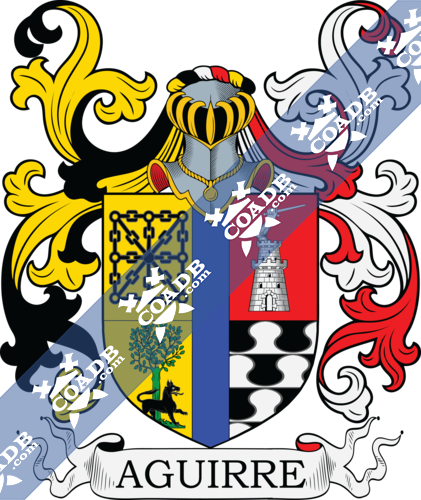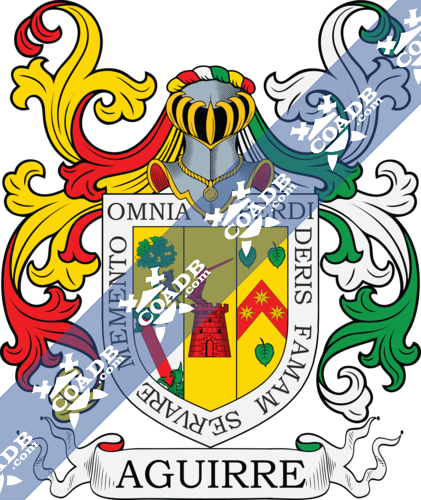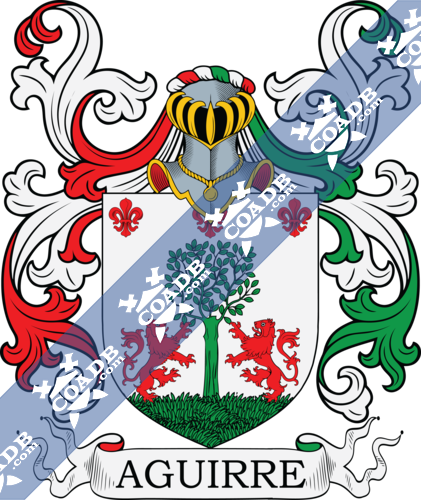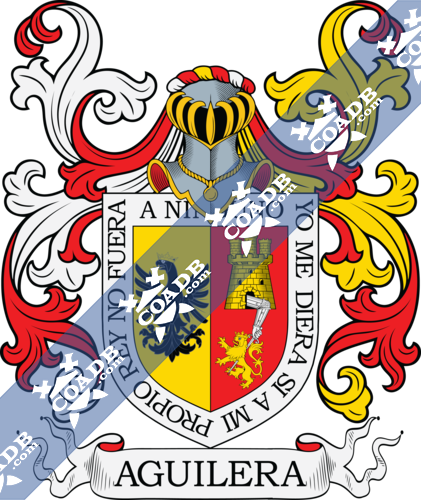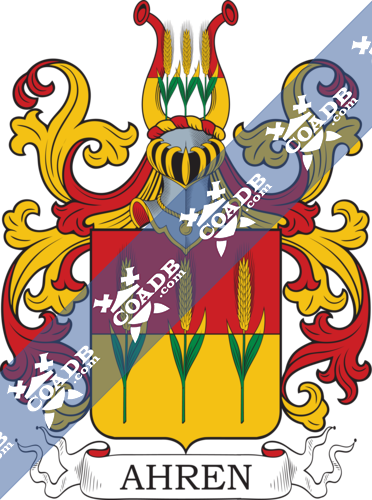Aguirre Family Crest, Coat of Arms and Name History
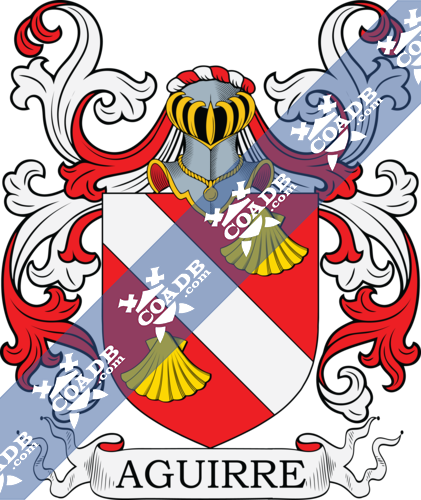
Aguirre Coat of Arms Gallery
Don’t know which Coat of Arms is yours?
We can do a genealogical research. Find out the exact history of your family!
Learn MoreSurname Meaning, Origin, and Etymology
During the middle age, many surnames started to be seen in Spain, and there was always an interesting origin for each one. The use of surnames began as a way of distinguishing people with the same first name and to assign one, it was considered a special or unique feature of the people who were going to bear it such as his profession or the name of the father. Another motive to bear a certain surname was the place in which the person used to inhabit or where he or she was born and also was considered the name of the land that the person owned if he was a landowner. Such is the reason behind Aguirre, which was used in the first place by people who lived in places called Aguirre or Agirre or Aguir, like villages or towns.
Aguirre comes from the Basque word “Ager” which means “visible or prominent”, so it is also probable that it was used by the people who lived in a very noticeable part of a village such as a castle, the marketplace or a hill. After receiving the surname, the bearer just passed it to his offspring which then they passed it to the next generation, even if they have moved away and their children don’t live in the place called Aguirre anymore.
One of the first records of this surname belongs to Lope de Aguirre, who got married to Beatris de Baltacar in Valladolid on February 15, 1535. The surname Aguirre was very popular in the Basque area of Spain and in the north-center coast of the Iberian Peninsula.
Spelling Variations
Spelling variations of a surname were something very common in the Europe of the middle age. During this period there were many people traveling from one country to another because of all of the wars fought in the whole continent. A consequence of it was that there were several cultures meeting each other and with that came the mixing of their surnames and the translations of some of them and after a time of doing it, many were translated in the wrong way. The scribes of that time used to write the words according to how they heard them, so each one wrote the words differently. There was also the fact that some families added suffix or prefix to their surnames to show their loyalties or just to distinguish themselves from other branches of the family. All of this caused that a single surname could have several different variations and in the case of Aguirre the most ones common were: Aguirre, Aguirra, Aguirri, Izaguirre, Yzaguirre, Agirre, Aguirrezabal and Aguirrezabala.
Popularity & Geographic Distribution
Aguirre doesn’t count on the same high popularity that other Spanish surnames do. Actually, according to the census of 2014, Aguirre has the 685th position in the rank of the most common surnames and it is used by just approximately 769,157 people in the world. It is most prevalent in Mexico and its highest density is in Nicaragua. The second country with the biggest amount of bearers of this surname is Argentina, and Colombia is in third place. As can being seen, all of these countries where Aguirre is popular are Spanish-speaker countries, because they were colonized by Spain after the voyages of Christopher Columbus. The surname Aguirre is the 507th most common surname in the United States as of 2000.
Early Bearers of the Surname
Even when Aguirre is not a very common surname, there are some records of old bearers such as Juan de Suso de Aguirre who was at witness at Forua on February 15, 1546, Asencio Aguirre who was made Christian on May 35, 1555 and Antonio de Aguirre who got married in Gorlitz, Viscaya on March 15, 1626. All of them were from Spain.
History, Genealogy, and Ancestry
As it said before Aguirre is not a popular surname, but fortunately there are high-detailed records that show the genealogy of some of its users. One of them is the conquistador of Chile and co-founder of its capital Santiago de Chile, Francisco de Aguirre de la Rua. Francisco was born in Castile, Spain in 1508, he was a soldier with a great record of battles and then a conquistador of Chile, he got married to María de Torres y Meneses, daughter of Hernando de Torres and Isabel Ortega in 1527. Francisco and María had five children, Constanza de Menses y Aguirre who was born in Spain and got married to Juan Jofré y Montensa, Eufrasia de Meneses who became a nun, Isabel de Aguirre y Torres who was also born in Spain and got married to Francisco de Godoy, Valeriano de Aguirre y Torres who was born in Spain and died in American while he fought against the natives “Colchaquíes” in 1564 in Tucumán and Hernando Aguirre y Torres who was born in Spain and had an important role in the army defending the city La Serena, Chile against pirates such as Francis Drake and also got married to Agustina de Matienzo y Toro, daughter of Juan de Matienzo de Peralta and Ana María de Toro Zelada y Carrion.
Hernando had several children, they were María de Aguirre y Matienzo who got married to Pedro Pastene y Seixas, Bernabela de Aguirre y Matienzo who got married to José de Carvajal Campofrío y Riberos, Ana de Aguirre y Matienzo who got married to Juan de Mendoza Butron y Mujica, Jacoba de Aguirre y Matienzo who got married to Juan de Loayza, Constanza de Aguirre y Matienzo who became a nun, Inés de Aguirre y Matienzo who got married Francisco de Riveros y Figueroa. Then there was the last daughter of Hernando de Aguirre y Torres, who was outside of his marriage, she was Isabel de Aguirre.
The record of the lineage continued with the children of Inés de Aguirre y Matienzo and Francisco de Riveros y Figueroa. These children were Ana de Aguirre y Riveros who didn’t have children, Fernando de Aguirre y Riveros who was born in La Serena and got married to Catalina Cortés Monroy y Tobar, daughter of Francisco Cortés Monroy y Tobar and Isabel de Pliego y Verdugo. Fernando and Catalina had several children, they were María Inés de Aguirre y Cortés who got married to Cristóbal Pizarro y Cajal, Isabel de Aguirre y Cortés who got married to Alonso de Soto y Córdoba, Francisco de Aguirre y Cortés who got married to Catalina Gómez de Silva y de la Torre and then got married again to Micaela Lisperguer y Andía.
The children of Francisco de Aguirre y Cortés were Francisco de Aguirre y Gómez de Silva, who became a captain and got married to Francisca Bartolina Gallardo y Riveros de Castilla and they had a son named Francisco Manuel Aguirre Gallardo who died at the age of 40 without children. Then there were Juan Fernando de Aguirre y Silva who became a cleric, Isabel de Aguirre y Lisperguer who got married to Antonio Marín Riveros, José Ignacio de Aguirre y Lisperguer who got married to Rosa Gallardo de Riveros and had five children.
The children of José Ignacio and Rosa were José de Aguirre y Gallardo who got married to Agustina de Fuica y Marín, Micaela de Aguirre y Gallardo who got married to Ventura Marin Cisternas and María Rosa de Aguirre Gallardo who got married to Juan Gregorio Pedro Cortés Castillo. José Ignacio had two more daughters outside his marriage, they were Bernarda de Aguirre y Guerra who got married to José Rodríguez y Rivera and Francisca de Aguirre y Guerra who got married to Juan José Pedro Cortés Monroy del Castillo.
The fifth and last child of Francisco Aguirre y Cortés was a daughter he had outside his marriage with a woman called Inés Juaréz and she was named María de Aguirre y Juárez. María was born in Sotaquí in 1668, she grew up and got married to Asencio (Francisco) Cortés Zeberinos, son of Francisco Ramón Cortés de Monroy y Riveros and María Zeberinos.
The fourth child of Fernando de Aguirre y Riveros and Catalina Cortés Monroy y Tobar was Fernando de Aguirre y Cortés Monroy who became a General in the army and occupied several charges in the government. He got married to Ana Rita Hurtado de Mendoza y Pizarro, daughter of Alvaro Hurtado de Mendoza y Quiroga and Margarita Pizzaro y Cajal. Fernando and Ana Rita had three children, Alvaro de Aguirre y Hurtado de Mendoza who didn’t got married or had offpsgring, Josefa de Aguirre y Hurtado de Mendoza who got married to Antonio Niño de Cepeda y Mendoza and Fernando de Aguirre y Hurtado de Mendoza who got married to María Josefa de Irarrázaval y Bravo de Saravia. This last marriage had four children, Fernando de Aguirre e Irarrázaval, José de Aguirre e Irarrázaval, Agustina de Aguirre e Irarrázaval who got married to Luis José Varas Ponce de León y Covarrubias and Miguel de Aguirre e Irarrázaval who got married to Isabel Fuica Irarrázaval.
Fernando de Aguirre y Riveros had two more sons, but they were outside his marriage, they were Fernando de Aguirre and Francisco de Riveros Figueroa. There are no records of the name of their respective mothers.
The other children of Inés de Aguirre y Matienzo and Francisco de Riveros y Figueroa were María de Riveros y Aguirre who became a nun, Juan de Villalobos who became a cleric, Bernabé de Riveros, Lorenza de Riveros y Aguirre, Teresa de Riveros, Francisco de Riveros y Aguirre, Agustina de Riveros y Aguirre, Inés de Riveros y Aguirre and José de Riveros y Aguirre.
Francisco de Aguirre de la Rua had more children, but outside his marriage, they were Marco Antonio de Aguirre, Florián de Aguirre, Diego de Aguirre, Nicolás de Aguirre, Gracián de Aguirre and Pedro de Aguirre.
Early American and New World Settlers
After the Europeans find America, many of them decided to move to the new continent and look for a new life with better opportunities. When they arrived they brought their surnames with them and this was how these last names from the old continent started to be used in America. In the case of Aguirre some of them who arrived in America in the 16th century were: Lope de Aguirre (1518-1561 who arrived to Peru along with Pizarro, Hurtado de Aguirre who arrived in America in 1528, Francisco Aguirre who landed in New Granada in 1552, Juan Aguirre who landed in New Spain in 1576 and another Francisco Aguirre who fought shoulder to shoulder with important figures of the colonization of the American continent such as Pizarro in Peru and Valdivia in Chile, and then passed away in 1580.
There are more records of immigrants with the surname Aguirre in the 19th century such as Francisco Antonio Aguirre who arrived in Puerto Rico in 1804, another Francisco Aguirre who was a conquistador in Chile, Domingo Aguirre who arrived in America with Jiménez de Quesada and was among the founders of the city of Bogotá in Colombia, Hurtado de Aguirre who landed in America in 1828 and Ignacio Aguirre who arrived in New Orleans in 1829.
Mottoes
We were unable to locate any documented mottoes for the Aguirre family.
Grantees
We were unable to locate any documented grantees for the Aguirre family.
Notables
There have been many bearers of the surname Aguirre who have played important roles in different areas such as politics, sports, and science. Some of these Aguirre were: Amado Aguirre Santiago (1863-1949) a Mexican general and politician, Eduardo Aguirre (b. 1946) the current United States Ambassador in Spain, Gastón Aguirre (b. 1981) a football player from Argentina, Gonzalo Aguirre (1908-1996) a Mexican anthropologist, Mason Aguirre (b. 1987) an American snowboarder, Henry John Aguirre (1931-1994) an American Major League Baseball pitcher, Alfonso Anda Aguirre (b. 1919) a philosopher and lawyer from Spain, Joaquín Aguirre Lavayen (1921-2011) a Bolivian writer, entrepreneur, diplomat and inventor, Ricardo Aguirre (1939-1969) a Venezuelan Musician who was one of the biggest exponent of the folk music called “Gaita”, he was known as “El Monumental”, Celso Aguirre Bernal (1916-1997) a Mexican writer and historian, Francisco de Paula Aguirre (1875-1939) a Venezuelan composer, Esperanza Aguirre (b. 1952) a Spanish politician and Margarita Aguirre (1925-2003) a writer from Chile.
Blazons & Genealogy Notes
1) Guipuzcoa – De gueules à la bande d’argent acc de deux coquilles d’or. English: Gules a bend argent surrounded by two escallops or.
2) Guipuzcoa – Écartelé au 1 d’or aux chaînes de Navarre de sable au 2 de gueules à une tour de deux étages sommée d’un dextrochère armé issant des créneaux brandissant une épée le tout d’argent au 3 d’or à un arbre terrassé de sinople et un loup passant et contourné de sable brochant sur le pied du fût au 4 fascé-nébulé de sable et d’argent de quatre pièces Au pal d’azur brochant sur les écartelures. English: Quarterly First or the chains of Navarre sable Second gules a tower of two floors surmounted by an armoured right arm issuant from the battlements brandishing a sword all argent Third or a tree on a mount all vert and a wolf passant reversed sable covering the foot of the trunk Fourth barry nebuly sable and argent of four pieces a pale azure covering the quartering.
3) Biscaye – Tiercé en pal au 1 coupé a d’or au chêne de sinople englanté d’or senestré d’une louve au naturel allaitant deux petits et rampante contre le fût de l’arbre b d’argent à la bande de gueules engoulée de deux têtes de dragon de sinople au 2 d’or à la tour de gueules sommée d’un dextrochère issant des créneaux armé d’argent brandissant une épée du même au 3 d’or au chevron de gueules ch de trois étoiles (8) d’or et acc de trois panelles de sinople la tige en haut L’écu entouré d’une bordure d’argent ch des mots OMNIA SI PERDIDERIS FAMAM SERVARE MEMENTO. English: Tierced in pale First per fess a: or an oak tree vert fructed (acorned) or to the sinister a she-wolf proper going on two paws and rampant against the trunk of the tree b: argent a bend gules being swallowed at each end by two heads of dragons vert Second or a tower gules surmounted by an armoured right arm issuant from the the battlements brandishing a sword of the same Third or a chevron gules charged with three etoiles of 8 points or and surrounded by three poplar leaves vert stems upwards over the whole shield a bordure argent charged with the words OMNIA SI PERDIDERIS FAMAM SERVARE MEMENTO.
4) Espagne – D’argent à un arbre de sinople sur une terrasse de même accosté de deux lions affrontés de gueules rampant contre le fût et acc de trois fleurs-de-lis de gueules rangées en chef. English: Argent a tree vert on a mount of the same surrounded by two lions facing each other gules rampant against the trunk at surrounded by three fleur-de-lys gules arranged in chief.

